Fine Antique Oriental Rugs XIII, Austria Auction Company, Vienna, 15 December 2018
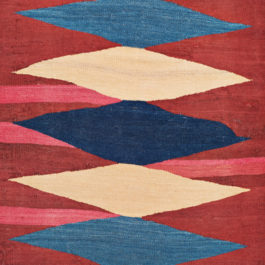
Fine Antique Oriental Rugs XIII
8 images
Select highlights from Udo Langauer’s upcoming sale of antique oriental rugs. About 70% of the 192 lots offered comprise pieces, predominantly very graphic flatweaves of Persian, Transcaucasian and Anatolian origin, from the excellent collection of the late Theo Häberli.
- Lot 28, Konya Kilim, Turkey, mid 19th century. Theo Häberli private collection. Estimate: €3,000 – 4,000.
- Lot 32, Bidjar Kilim door curtain with inscriptions, Persia, late 19th century. Theo Häberli private collection. Estimate: €2,000 – 3,000.
- Lot 33, Shahsavan Kilim, Azerbaijan, 19th century. Theo Häberli private collection. Estimate: €3,000 – 4,000.
- Lot 79, Kaitag, Caucasus, 18th century. Austrian private collection. Estimate: €4,000 – 6,000.
- Lot 94, Large Chancay textile, Peru, 1200 – 1470 A.D. Austrian private collection. Estimate: €3,000 – 4,000.
- Lot 108, Alpujarra wedding rug with inscriptions, Spain, 16th century. Theo Häberli private collection. Estimate: €6,000 – 8,000.
- Lot 170, Kamu Sofreh, Persia, ca. 1930. Theo Häberli private collection. Estimate: €500 – 800.
- Lot 174, Zoroastrian Silk textile, Persia, 19th century. Theo Häberli private collection. Estimate €1,200 – 1,800.
To an even greater extent than its very successful immediate predecessor last September, Udo Langauer’s upcoming sale of antique oriental rugs at Austria Auction Company’s Palais Breuner saleroom in Vienna’s Singerstrasse on Saturday 15 December 2018 includes quality rugs from the excellent collection of the late Theo Häberli.

Lot 31, Karadag Kilim (detail), Persia, early 20th century. Theo Häberli private collection. Estimate: €1,000 – 1,400.
About 70% of the 192 lots offered comprise pieces, predominantly very graphic flatweaves of Persian, Transcaucasian and Anatolian origin, from this Swiss collection, which was probably less well known than it should have been during the collector’s lifetime. Indeed, some of the kilims and covers bear comparison with better known examples published (and sold) by luminaries such as Ignazio Vok and Hamid Sadighi Neiriz. All are offered without reserve, and the estimates are for the most part very reasonable and should be exceeded in many instances.

Lot 33, Shahsavan Kilim (detail), Azerbaijan, 19th century. Theo Häberli private collection. Estimate: €3,000 – 4,000.
At the core of the consignment is a comprehensive and varied cluster of more than two dozen 19th- and early 20th-century Shahsavan kilims from the province of Azarbayjan. One of the most notable of these is lot 33, the Torkmanchay kilim chosen by Parviz Tanavoli as the cover illustration for his 1988 book Persian Flatweaves, which is estimated at €3,000-4,000. Added to these are almost twenty other Shahsavan flatwoven items (kilim, sumakh and verni technique), from both sides of the modern Iranian/Azerbaijan border including assorted covers, bags and trappings.

Lot 32, Bidjar Kilim door curtain with inscriptions (detail), Persia, late 19th century. Theo Häberli private collection. Estimate: €2,000 – 3,000.
Another notable piece previously published by Tanavoli is a Kurdish Bijar area kilim pardeh or door curtain, with an inscription of Sufi inspiration, lot 32, estimated at €2,000-3,000. Mr Häberli also had a penchant for the so called sofreh of Kamo, south of Kashan in central Persia, which were also championed by Tanavoli in a small 1998 catalogue. There is a baker’s dozen of these very optical flatweaves included in the sale, together with other functionally and visually similar weavings of other attributions such as Varamin. Each of the Kamo sofreh is estimated at just €500-800.

Lot 170, Kamu Sofreh (detail), Persia, ca. 1930. Theo Häberli private collection. Estimate: €500 – 800.
Of course, not everything is flatwoven, and the most interesting of the handful of pile items from the Häberli collection is a rare Spanish carpet (lot 104), in loop-pile technique, with an enigmatic inscription and highly stylised rampant crowned lions (the arms of Léon). Probably Alpujarra and 18th century (it is optimistically catalogued as 16th), it was previously advertised by Michail di David Sorgato in Milan (HALI 73, 1994), and is now estimated at €6,000-8,000).

Lot 108, Alpujarra wedding rug with inscriptions (detail), Spain, 16th century. Theo Häberli private collection. Estimate: €6,000 – 8,000.
The remainder of the sale, mainly from Austrian, German and other European collections, includes a number of Turkmen pieces as well as a purple-silk-ground, so called ‘Lakai-style’, Uzbek suzani (lot 140, estimate €3,000-4,000), and a large pre-Columbian Chancay painted textile (lot 94, estimate €3,000-4000).



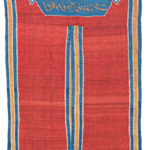
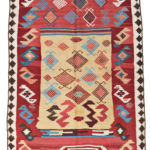


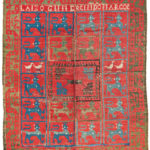
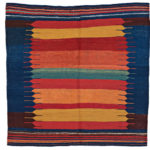
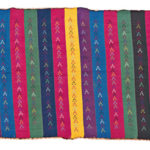











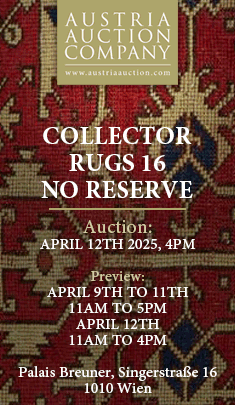













Comments [0] Sign in to comment